 |
 08-17-2015, 11:44 PM
08-17-2015, 11:44 PM
|
#1
|
|
Senior Member
Join Date: May 2015
Location: Phoenix, AZ
Posts: 144
|
200 Watts solar on my A-Frame
This is something I have been planning since I got the A-128. Previously I had posted about building a custom battery box and installing a solar charge controller. I have been using two portable 30 watt panels sitting on the ground, cabled to the battery box. I've been wanting to mount some larger panels permanently to the front slope of my A-Frame. I have finally got around to it, and took the new setup boondocking this weekend.
First, I welded up two mounting bars. Here is a photo of one finished and painted, and the other one ready for paint:

Ok, now here are the two panels mounted on the racks, ready for placement on the trailer:
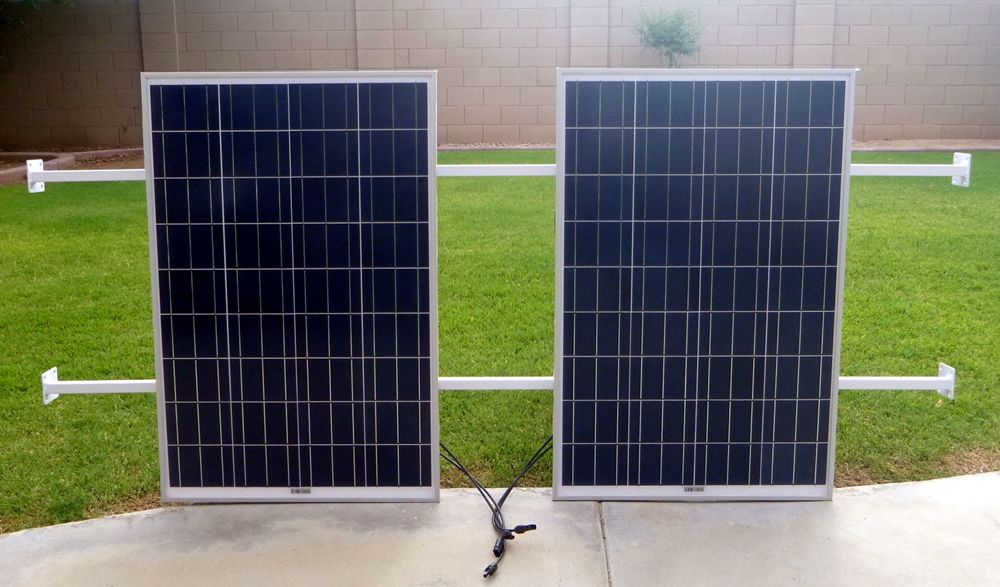
Here is the trailer at camp showing the panels mounted:
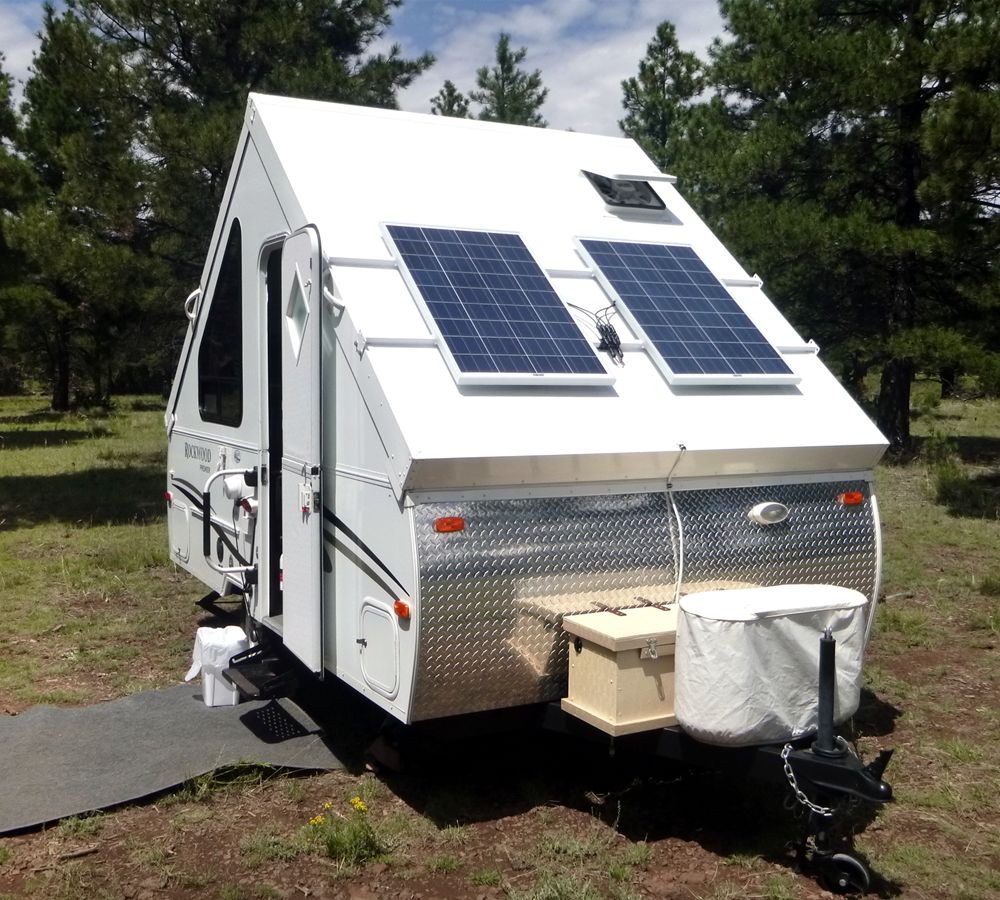
Here is a closer view of the panels mounted on the front slope: I used marine 10 gauge duplex cable (white sheath) to run the solar current to the battery box. I used some leftover 3M Extreme Sealing Tape to stick the cable down on the fiberglass. I didn't want the cable flapping and beating on the fiberglass while running down the highway. I also zip-tied the black solar panel cables to the solar panel frames to keep those cables from flogging the fiberglass as well.
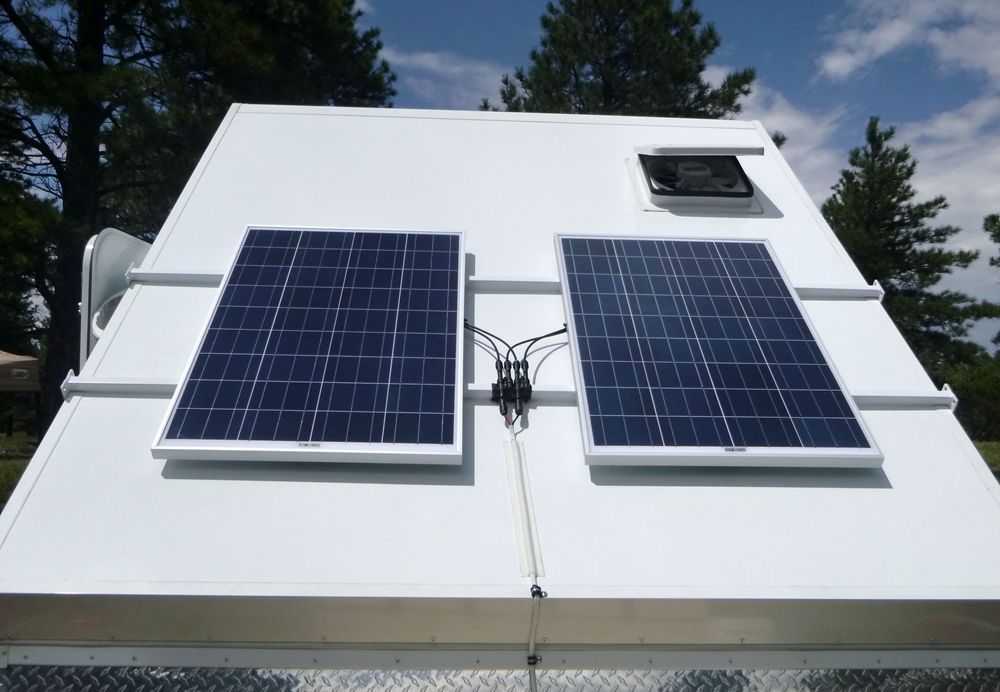
Next is a sideways detail shot. Lag bolts attach the racks to the side of the roof through the aluminum roof frame. The racks have clearance to the fiberglass panel because of a little natural sag in the fiberglass between the aluminum roof frames on each side.
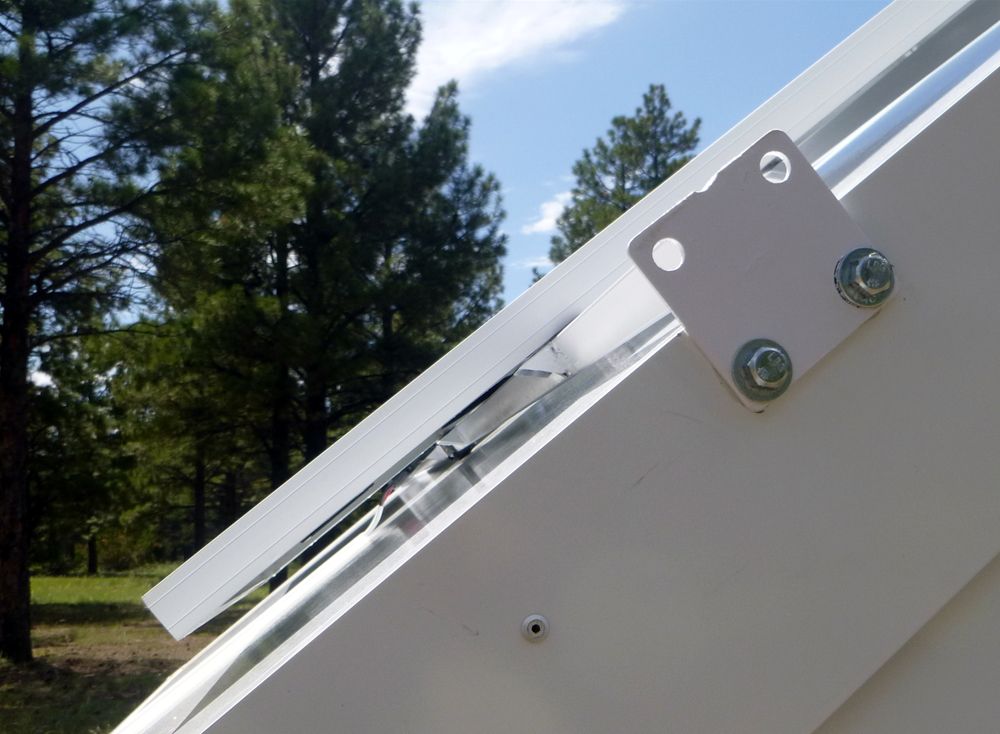
With permanently mounted panels, I needed a way to disconnect the solar charge current from going to the charge controller when the battery is disconnected. The charge controller is not happy getting solar power if the battery is not connected. So the sequence for powering up is 1) Connect battery power to the trailer using the master battery cutoff switch (red flag thingy); 2) Flip up the solar current switch to send solar power to the charge controller. Power down in reverse, first turning off the solar charge current switch, then the master battery cutoff switch. Also when the trailer is connected to the vehicle, I turn on the master battery switch, but leave the solar charge current switched off. I don't know what effect sending solar power backwards to the vehicle voltage regulator will do. I think not good things.

And finally, here's a picture of successful solar boondock camping:
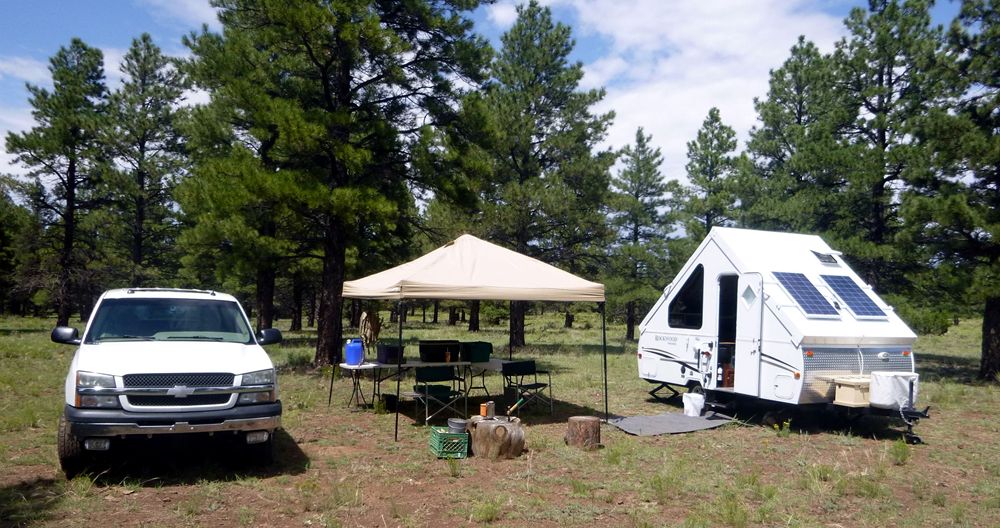
Next enhancement: A DC compressor driven refrigerator like this one:
Amazon.com: Dometic CFX-65DZUS Portable Freezer/Refrigerator - 2.2 cu. ft.: Automotive
I now have the power generation and storage capacity to run one indefinitely.
Enjoy!
__________________
Dan
2012 Rockwood A128 (no S)
2016 Ram Power Wagon 6.4L Hemi 4x4
|

|

|
 08-18-2015, 12:05 AM
08-18-2015, 12:05 AM
|
#2
|
|
Senior Member
Join Date: May 2015
Location: Phoenix, AZ
Posts: 144
|
Lighted Canopy
Oh yeah, one more bit of 12 volt coolness: See that canopy? I installed an exterior 12 volt cig socket outlet on the outside of the trailer near the factory AC outlet. Then I built a 16 foot long cable made of low voltage landscape cable that goes under my entry rug to the canopy. Hanging from the canopy are four 12vdc LED light bulbs. The exterior power socket is switched from inside the trailer. So I can turn on or off the canopy lighting from inside the trailer! I'm having too much fun with this stuff, I'm telling you!

__________________
Dan
2012 Rockwood A128 (no S)
2016 Ram Power Wagon 6.4L Hemi 4x4
|

|

|
 08-18-2015, 06:28 AM
08-18-2015, 06:28 AM
|
#3
|
|
Senior Member
Join Date: Dec 2014
Location: USA
Posts: 119
|
Dan-
Amazing and very cool outfit you have come up with. Thought of coming up with a semi-hard cover for the panels yet? This would stop energy production when traveling and also protect panels from road debris. I've got the Renogy 100W solar suitcase and love it. Versatile and has been able to produce enough power to keep me going.
|

|

|
 08-18-2015, 10:08 PM
08-18-2015, 10:08 PM
|
#4
|
|
Senior Member
Join Date: May 2015
Location: Phoenix, AZ
Posts: 144
|
Hi 61cubby,
No I had not thought of that. I don't think that the panels are vulnerable, and with the solar power stopped at the switch, I don't see a need to to cover them to keep them from generating power. When you say semi-hard covers, that means that I would have these large "things" to manage at camp when they are off the panels. I guess they could be stowed underneath the trailer while camping, but again, I don't think that's necessary. Thanks for the thought though.
Let me mention that I have my two 30 watt panels hinged together and I built a thin plywood box to house, protect, and transport them. Folded up and in the box, it is much like the Renogy suitcase panels that you have. A buddy of mine just got the 100 watt Renogy suitcase panels. He and I built a 35 amp-hour portable power pack from a large plastic ammo can. He's a tent camper and he needs to run a CPAP machine, so this portable system lets him do that.
__________________
Dan
2012 Rockwood A128 (no S)
2016 Ram Power Wagon 6.4L Hemi 4x4
|

|

|
 08-19-2015, 06:30 PM
08-19-2015, 06:30 PM
|
#5
|
|
Member
Join Date: Nov 2013
Location: Phoenix
Posts: 34
|
Nicely done. My only thought is that the panels could of had a pivot point on the upper side with fixed or extendable legs on the lower side making the panels adjustable so that you wouldn't have to park the same way every time you camp....DAMHIKT
GW.......facing east!
|

|

|
 08-19-2015, 06:54 PM
08-19-2015, 06:54 PM
|
#6
|
|
Senior Member
Join Date: Dec 2014
Location: St Simons Island, GA
Posts: 1,234
|
Just curious, why didn't you connect the panels in series rather than parallel? That way you would not need the multiple connectors AND you would have higher voltage and less amperage which requires much smaller wiring and less current loss.
You can leave the system connected to the batteries, assuming you are using a solar controller as it will not allow voltage "back into the regulator". I never turn mine off. If the batteries need charging, they get it, either from the TV, converter when plugged in or from the solar panels. The controller acts as a diode to the system.
I hope you have breaker switches between the panels/controller and batteries/controller. They act as fuses and/or on/off switches.
__________________
 Aviator Wright Flyer #1919
Army Pathfinder Vietnam, 3 tours
DAV, MOPH, VFW, NRA, 1stCav. ABN
|

|

|
 08-19-2015, 08:58 PM
08-19-2015, 08:58 PM
|
#7
|
|
Senior Member
Join Date: May 2015
Location: Phoenix, AZ
Posts: 144
|
Quote:
Originally Posted by GeeDubb

... the panels could of had a pivot point on the upper side with fixed or extendable legs on the lower side making the panels adjustable so that you wouldn't have to park the same way every time you camp
|
You're right that for best power production I need to point the front of the trailer due south when I park. Your suggestion would allow the panels to be adjusted for optimum angle if I camped in radically different latitudes, but I would still have to park pointed due south ... unless I went to Australia I guess. Then I would have to point north!
Quote:
Originally Posted by Blackhat6mike

Just curious, why didn't you connect the panels in series rather than parallel? That way you would not need the multiple connectors AND you would have higher voltage and less amperage which requires much smaller wiring and less current loss.
|
Because I have a PWM controller, not a MPPT controller that can perform the 24V to 12V DC-to-DC conversion. The PWM controller I have CAN accept 24V solar input (which is actually in the high 30's of voltage), but then I get 24V output which does me no good to feed a single (but large) 12V battery.
Quote:
Originally Posted by Blackhat6mike

You can leave the system connected to the batteries, assuming you are using a solar controller as it will not allow voltage "back into the regulator". I never turn mine off. If the batteries need charging, they get it, either from the TV, converter when plugged in or from the solar panels. The controller acts as a diode to the system.
|
Well, I really didn't know what effect backfeeding power on the charging line from the vehicle would have on the vehicle's voltage regulator. Maybe that's OK, but since I didn't know, I figured that was an experiment that I didn't need to try ...
Quote:
Originally Posted by Blackhat6mike

I hope you have breaker switches between the panels/controller and batteries/controller. They act as fuses and/or on/off switches.
|
I have fuses - which aren't fun to use as switches.
Thanks for the replies!
__________________
Dan
2012 Rockwood A128 (no S)
2016 Ram Power Wagon 6.4L Hemi 4x4
|

|

|
 08-19-2015, 09:39 PM
08-19-2015, 09:39 PM
|
#8
|
|
Senior Member
Join Date: Dec 2014
Location: St Simons Island, GA
Posts: 1,234
|
I think you will find that the controller takes the voltage in from the panels and converts it to the correct voltage of the batteries be it 12 or 24 VDC. Two 100 watt panels in series will produce a max of 44 volts if working at 100%, which they never will except on paper. Your PWM controller should be good for 100 VDC if my memory serves me well.
There is a huge difference in the efficiency between the PWM and a MPPT controller, thus the difference in price. I went down that road when I first started my solar system. I now have 600 watts, 3 panels in series then paralleled to the other 3 in series. My max voltage reaches 63 volts and at times, up to 12 amps, just not both at the same time.
I think you will find the MPPT controller actually do produce as much as 30% more juice than the PWM. If you are only using one battery, that will make a difference. I have 500+ amp hrs of batteries so I need all I can get. JMHO
__________________
 Aviator Wright Flyer #1919
Army Pathfinder Vietnam, 3 tours
DAV, MOPH, VFW, NRA, 1stCav. ABN
|

|

|
 08-19-2015, 10:19 PM
08-19-2015, 10:19 PM
|
#9
|
|
Senior Member
Join Date: May 2015
Location: Phoenix, AZ
Posts: 144
|
Thanks mike,
I understand that an MPPT will be more efficient. But an A-Frame is but one step above a tent, it is not a house like your rig! 200 watts and 200 amp-hours on PWM is a balanced and adequate system for my humble little portable cabin in the woods.
I just double checked my controller's spec sheet, max input voltage is 40V. You might be right that it will down convert panels in series to 12V, but if it does, it will do that by PWM chopping the high voltage down to the three stage charge voltages. That means that it would waste even more power since it cannot do the DC to DC conversion to increase amps while decreasing voltage, as an MPPT will do.
__________________
Dan
2012 Rockwood A128 (no S)
2016 Ram Power Wagon 6.4L Hemi 4x4
|

|

|
 08-20-2015, 08:15 AM
08-20-2015, 08:15 AM
|
#10
|
|
Senior Member
Join Date: Jun 2014
Posts: 276
|
That is some nice work, and
I appreciate your sharing it with everyone. 
My only concern is the amount of tongue weight that is added from everything.
I am sure your tow vehicle can handle it, but maybe the new tongue weight is a bit much for some tow vehicles.
Happy camping! 
|

|

|
 08-20-2015, 09:52 AM
08-20-2015, 09:52 AM
|
#11
|
|
Senior Member
Join Date: May 2015
Location: Phoenix, AZ
Posts: 144
|
Thanks mickrock,
That was definitely a concern of mine. I can tell you that the roof takes a bit more muscle to raise. My trip from home to camp spot was about 150 miles one way that includes an elevation change of 1400 feet to over 8000 feet. My rig remains level from front to back, and I had no issues of bad handling, including passing and being passed by big rigs. I love the low profile of the trailer under travel, especially being able to see out the back window in the rear view mirror. Attached photo is of the rig at a Taco Bell stop on the way home.

__________________
Dan
2012 Rockwood A128 (no S)
2016 Ram Power Wagon 6.4L Hemi 4x4
|

|

|
 08-20-2015, 03:12 PM
08-20-2015, 03:12 PM
|
#12
|
|
Senior Member
Join Date: May 2015
Location: Phoenix, AZ
Posts: 144
|
Inverter
Hey Blackhat6mike, you still there?
I like what you've done, installing an inverter off your solar DC system, to at least one AC outlet, that you switch on or off as needed. Is it just the single outlet off the inverter that you show in your photos? What make and model are you using? I don't have a big need for AC when camping, but I do have a few battery powered devices for which the only charger I have is an AC wall-wart. I have a Harbor Freight 400 watt inverter that so far I just open the lid on my battery box and clamp directly to the battery. That wasn't so good when I got rain dumped on me this weekend, so I am considering rewiring a couple of my existing AC outlets to attach (only) to an inverter. The Harber Freight unit doesn't have the handy remote turn-on ability though.
__________________
Dan
2012 Rockwood A128 (no S)
2016 Ram Power Wagon 6.4L Hemi 4x4
|

|

|
 08-27-2015, 08:16 AM
08-27-2015, 08:16 AM
|
#13
|
|
Senior Member
Join Date: Aug 2013
Posts: 223
|
You may want to look at a Norcold 12 vdc 120 volt Freezer Fridge combo for your compressor drive fridge. I have seen them used on Altos with their built 190 W solar array. Owners seem quite happy with the automatic switching capability and the priced seems to be about the same. Also you will probably want to get a Girard on demand water heater. Just thought I would mention that one. Again replace of the the standard 6 gallon heater is about the same and hooking it is relatively easy or so I have been told.
__________________
SFC USA RETIRED
2014 FJ Cruiser
2014 T12DDST
Its Cute but......
Total (2104-2017) 319 2018 (59)
|

|

|
 08-27-2015, 11:11 AM
08-27-2015, 11:11 AM
|
#14
|
|
Senior Member
Join Date: May 2015
Location: Phoenix, AZ
Posts: 144
|
Thanks for the heads-up! I think this one maybe?
http://www.amazon.com/Norcold-NR740B.../dp/B00AJVLGXA
It is rated at 3.75 amps of current draw when the compressor is running. Let's assume that would be 50% of the time over the course of 24 hours. That calculates to 45 amp-hours in a day, less than 25% of my battery capacity. But during sunlight hours, that current is fed from the solar panels while there is still more than enough solar current to concurrently recharge the batteries. Sounds good!
__________________
Dan
2012 Rockwood A128 (no S)
2016 Ram Power Wagon 6.4L Hemi 4x4
|

|

|
 09-09-2015, 11:42 PM
09-09-2015, 11:42 PM
|
#15
|
|
Senior Member
Join Date: May 2015
Location: Phoenix, AZ
Posts: 144
|
Quote:
Originally Posted by DanM-AZ

. . .
I don't have a big need for AC when camping, but I do have a few battery powered devices for which the only charger I have is an AC wall-wart. I have a Harbor Freight 400 watt inverter that so far I just open the lid on my battery box and clamp directly to the battery. That wasn't so good when I got rain dumped on me this weekend, so I am considering rewiring a couple of my existing AC outlets to attach (only) to an inverter. The Harber Freight unit doesn't have the handy remote turn-on ability though.
|
Well Blackhat6mike never responded about his inverter setup so I ended up figuring it out on my own. Here is a picture of the inside of the microwave cabinet with the microwave pulled out. The little labels I added to the photo detail a number of different electrical mods that I have done in there. This includes the addition of a small 300 watt pure sine wave inverter:
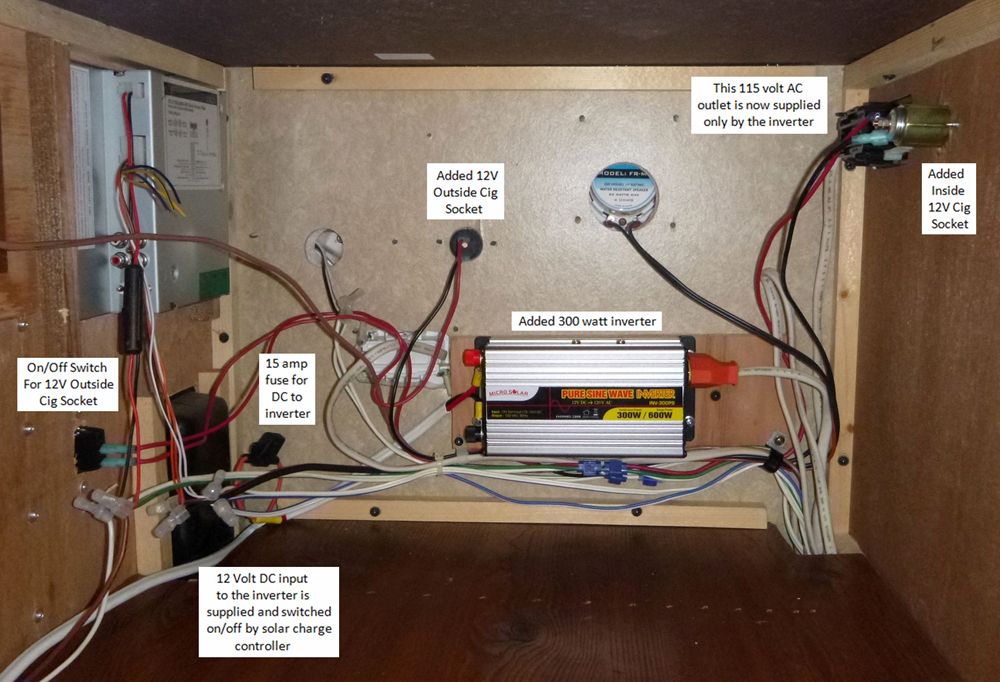
This is the inverter:
http://www.amazon.com/MicroSolar-300...JHD9YQ37HWECS0
What's nice about this unit is 1) it is a pure sine wave inverter; and 2) the cooling fan does not come on unless it is supplying more than 100 watts. That means that it does not waste power just running the fan when driving small loads.
The inverter is only connected to the one AC outlet in the back of the microwave cabinet. I switch the inverter on and off through the solar charge controller that is mounted on the forward surface of the microwave cabinet:

The DC wiring from the solar charge controller to the inverter is only 10 gauge wire. Being conservative, I fused the inverter DC supply with only a 15 amp fuse. What that means is that even though the inverter is rated for 300 watts, with a 15 amp fuse, power is limited to only 180 watts (12 volts times 15 amps). Generally I will be using far less than that because as I mentioned, my main purpose for AC while boondocking is to charge small devices through wall-warts, for example an electric razor and a rechargeable headlamp:

Still having fun making my electrical upgrades 
__________________
Dan
2012 Rockwood A128 (no S)
2016 Ram Power Wagon 6.4L Hemi 4x4
|

|

|
 |
 Posting Rules
Posting Rules
|
You may not post new threads
You may not post replies
You may not post attachments
You may not edit your posts
HTML code is Off
|
|
|
|
 » Recent Discussions
» Recent Discussions |
|
|
|
|
|
|
|
|
|
|
|
|
|
|
|
|
|
|
|
|
|
|
|
|
|
|
|
|
|
|
|
|
|